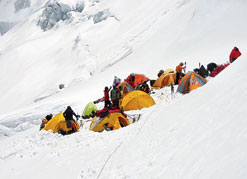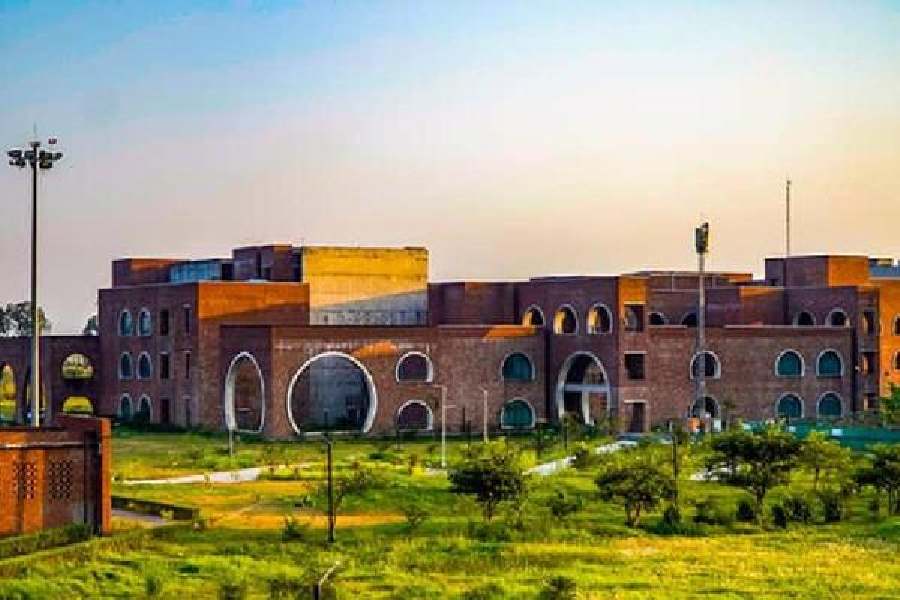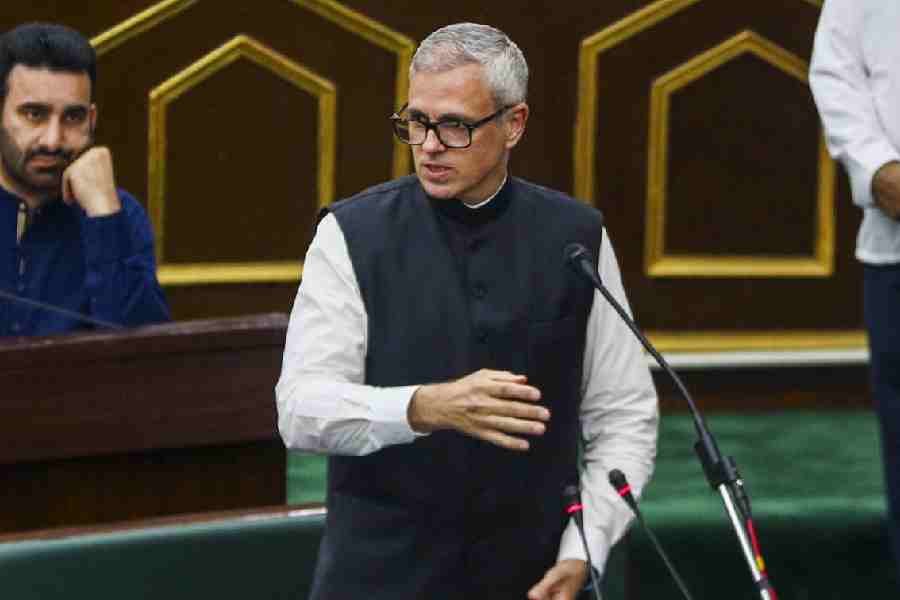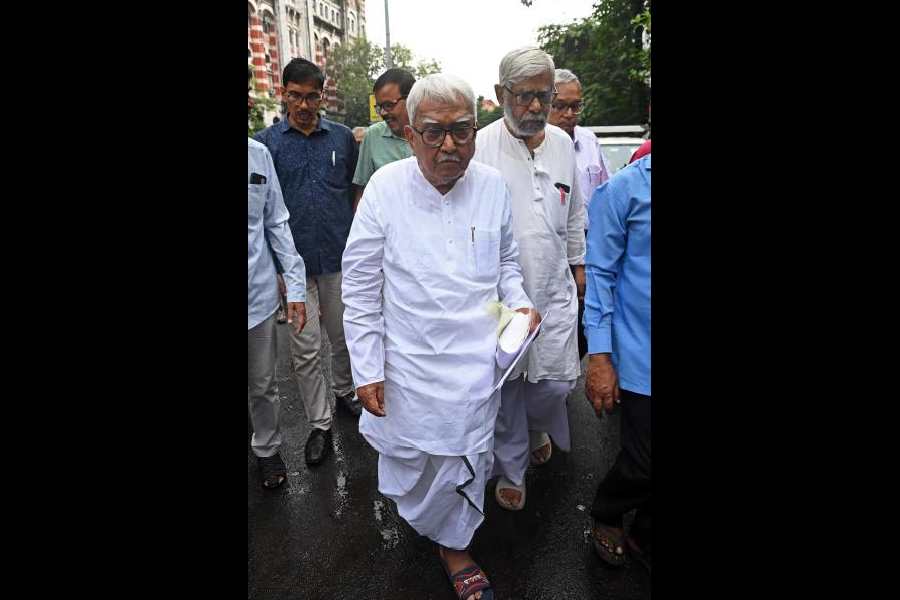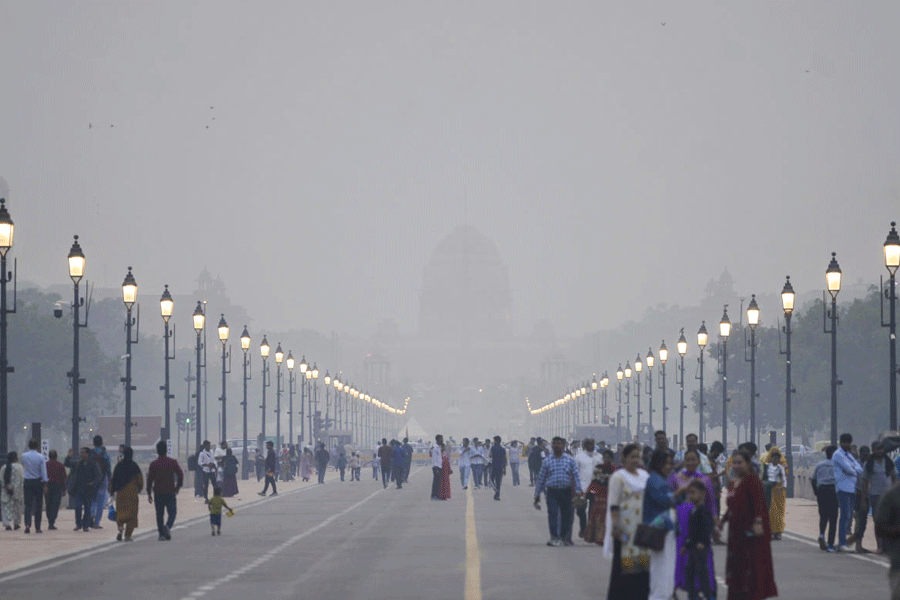 |  |
| Camp II at Mt Dhaulagiri and (right) trekking through an accident-prone region after an avalanche | |
We were in a cheerful mood while trekking down Myagdi Valley on our way to the Italian Base Camp from where we were to start our Dhaulagiri expedition. Our team included leader Basanta Singha Roy, Debasish Biswas and myself.
It is a pleasure trekking along Myagdi Valley located on the bank of Myagdi River. There are lush green plantations with picturesque villages. While trekking, we had no inkling that this expedition would prove near fatal.
We reached the Italian base camp on April 20 located at a height of 4,748 meters. The next day we decided to reach Chorbathan or Dhaulagiri Base Camp but heavy snowfall stretching over four days prevented us from moving further. We stayed put in our tents. By that time, expedition teams from France, Spain, Poland, Japan, Germany and Italy had reached the Italian Base Camp. We reached the Dhaulagiri Base Camp on April 26.
On April 28, all the expedition teams held a meeting and the Sherpas started fixing ropes on the ice walls for setting up camps. On April 30 around 2am we started for Camp-I and reached there the same day. The next day, we reached Camp-II, but we lost our way back to Camp-I due to heavy fog. Our Sherpa leader Pemba made an ice cave for us in which we took shelter. However, after a couple of hours, we found our way to the base camp. The process of acclimatisation continued till May 18.
All the expedition teams collected weather reports from their respective countries and decided to start the final journey for the summit on May 19 and the summit date was set on May 22 as weather reports from all the countries were good. This was misleading and was to result in near disaster later.
 |
| Members of the rescue team that came to save Basanta Singha Roy. |
Anyway, all the expedition teams together started their journey on May 19 from the base camp. We reached Camp-I the same day. On May 20, we reached Camp-II and the next day we pitched our tent at Camp-III at a height of 7,400 meters. We had to scale steep ice walls braving high wind. We decided to approach the summit on May 21but foul weather prevented us from moving ahead.
The expedition teams from Germany, Italy and Poland decided to abandon the expedition. But we decided to stay back. On May 22, around 11pm we started for the summit. After three hours, we reached 7,600 meters but I fell ill and took shelter in the fourth camp. My Sherpa Daya Wanchu also accompanied me. I could see Basantada and Debasishda approaching summit, braving a blizzard.
The next morning I felt better and decided to follow our team. But Wanchu forbade me. I returned to Camp-III. Around 3pm, we came to know that two members of the Spanish team had met with an accident. On May 24, early in the morning, Pemba Sherpa informed Wanchu over walkie-talkie that Basantada fell unconscious after his oxygen cylinder fell empty. Wanchu left to rescue him with a new oxygen cylinder and fruit juice. He tied Basantada with ropes and dragged him to camp-IV through ice. The next day, Pemba brought him to Camp-III with the help of a Japanese Sherpa risking his life. From Camp-III, Basantada was taken to a Kathmandu nursing home.
Our Dhaulagiri expedition may have flopped but we gathered enough experience for future expeditions. And thank God, all our team members are alive.
Malay Mukherjee
Pictures by author
Mt Makalu fell short by a rope
For a mountaineer, there is no bigger tragedy than abandoning an expedition 150m from summit. Yet this happened to me in my expedition to Mt Makalu this year. I, along with many other climbers from India and abroad, returned from 8,300m of Mt Makalu, a peak that is 8,463m. The reason was flimsy. There wasn’t enough rope to scale the summit.
After scaling Everest in 2011 and Lhotse in 2012, I had set my eyes on the fifth highest peak of the world. Makalu is a difficult peak and has not been attempted too many times. It is challenging because we, the climbers, have to dig out our own routes. I came for this expedition all alone representing Bally Bhagirathi club. I could not find any other participant, primarily because of the cost. The cost per head is over Rs 8 lakh for Mt Makalu.
 |  |
| Dipankar a few metres below the point till where he reached before abandoning the expedition and (right) crossing a steep gradient between Camp II and Camp III. | |
I left for Kathmandu from Calcutta on April 12 . From Kathmandu I took a flight first to Biratnagar and then to Tumlingtar. On April 17, I travelled by jeep to Num. Me and my Sherpa Migma started trekking from April 18 and on April 24 we set up base camp at 5,300m. We planned the expedition from this camp.
April 26: We set up advance base camp at 5,800 m and stayed there till April 30. The weather was bad and we needed to acclimatize. During this time, another Chinese team returned after summiting. However, one of the members was missing. The other member assumed that his friend was dead and the Sherpas went up to rescue the body. When the Sherpas came back to the base camp, they said that they had anchored ropes all the way to the summit, and so took all our extra rope.
May 1: We set up camp I at 6,300m.
May 2: We set up camp II at 6,600m
May 3: We returned to the advance base camp from camp II. From May 3 to 15, we were forced to stay back at the advance base camp as the weather was very bad and we could not move up. I made an attempt for the summit on May 15. Me and Migma went straight from the base camp to camp II. However, a strong blizzard blowing at 60 miles per hour forced us to abandon our plan. Since the weather did not change, we returned to the base camp on May 16. A second attempt was made on May 19 and we went directly to camp II.
 |
| Camp II at Mt Makalu |
May 20: We set up camp III at 7,400m. This place is called Makalu La. The trek from camp II to camp III is the most difficult climb. The gradient is very steep, at some points it is about 70 degrees. The climb is dangerous as there is a lot of hard ice here.
May 21: We set up camp IV at 7,900m
The final trek to the summit took place through the night of May 21. We were a total of 19 climbers from all over the world. From 8pm the climb started. We were surprised to see that there was not a single rope throughout the route. The Sherpa team had cheated us and taken all our ropes. Our only option was to put together all the remaining ropes that we had and move on. It was a steep climb. The Sherpas had a hard time making routes by cutting through hard blue ice. We followed, but sometimes we had to wait for hours for the way to clear.
At 6.15am, we reached 8,300m and stopped. We could not go any further because there was no rope. It was despairing to abandon an expedition 150m away from summit. Two other Indian climbers and I were contemplating to go to the summit without ropes, but the Sherpas said no. They did not allow us to take the risk. After waiting for over an hour, we returned. On the way down, we only stopped to collect our belongings from each camp. All my effort, time and money went to waste.
Dipankar Ghosh
Pictures by author

